Skordalia is a creamy, garlicky dip that’s perfect for spreading on bread, dipping vegetables, or serving as a side dish. It is a classic Greek dish that has been a staple of Greek cuisine for centuries. If you’re a fan of bold flavors and lots of garlic, this recipe is a must-try. Follow this step-by-step guide on how to make the ultimate skordalia at home and treat all garlic lovers with an amazing Greek dip.
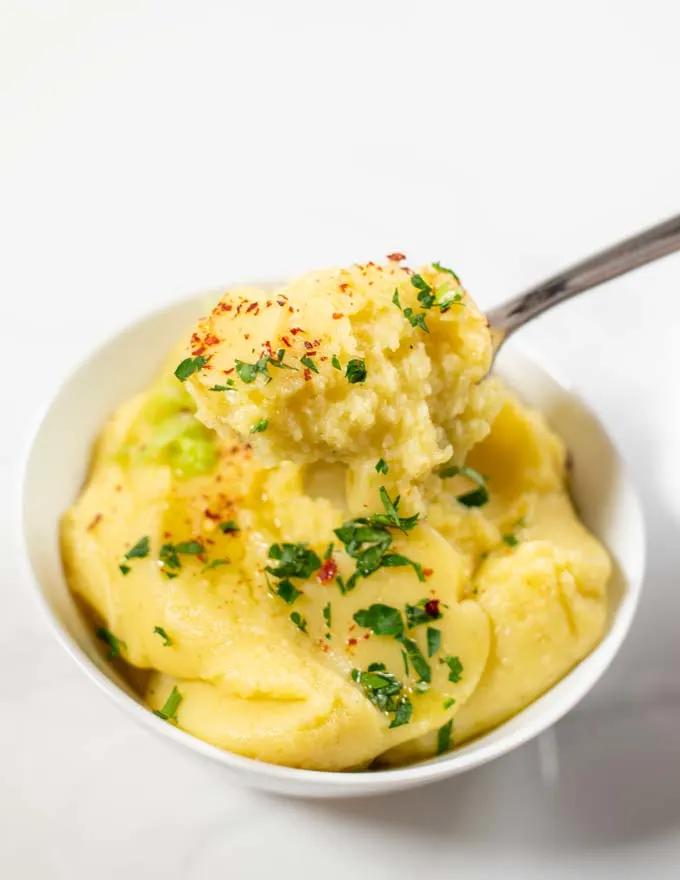
What is skordalia sauce made of?
Skordalia is a traditional Greek sauce or dip that has been enjoyed for centuries. The recipe for this flavorful dish typically includes garlic, olive oil, and a base ingredient such as mashed potatoes, bread, or nuts like almonds or walnuts. The preparation of skordalia can vary depending on the region and personal preferences.
To make skordalia, you’ll need garlic cloves, olive oil, a base ingredient (potatoes, bread, or nuts), salt, vinegar or lemon juice for acidity, and water (if needed to adjust the consistency). The garlic is typically crushed or finely minced and mixed with the olive oil to create a thick paste. The base ingredient is then added and mashed together until smooth. Salt and vinegar or lemon juice are added to taste, and water can be added to adjust the consistency to your liking.
Skordalia is often served as a side dish or accompaniment to fish, meat, or vegetables. Its strong garlic flavor and rich, creamy texture make it a perfect complement to a variety of main dishes. You may come across different recipes with additional ingredients or variations in preparation, but the basic recipe for skordalia remains a beloved and timeless classic.
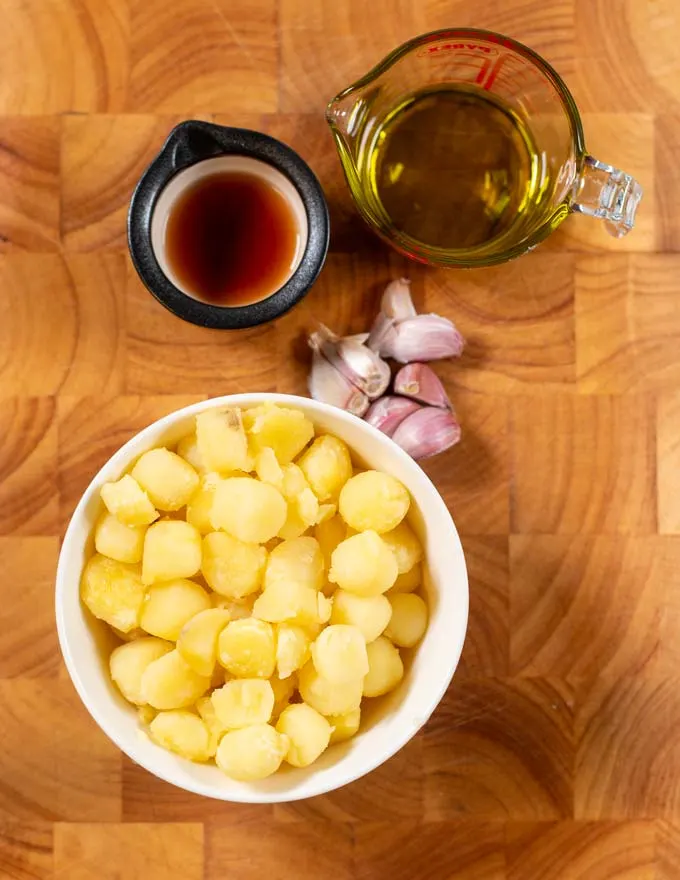
What is the difference between greek garlic sauce and skordalia?
The terms “Greek garlic sauce” and “skordalia” are sometimes used interchangeably, but they can refer to different preparations. While Skordalia is a Greek garlic sauce, it has a specific composition and texture that distinguishes it from other garlic-based sauces.
The garlic provides a strong flavor, and the sauce has a creamy consistency. Skordalia may also include ingredients like vinegar or lemon juice for acidity, salt, and sometimes water to achieve the desired texture.
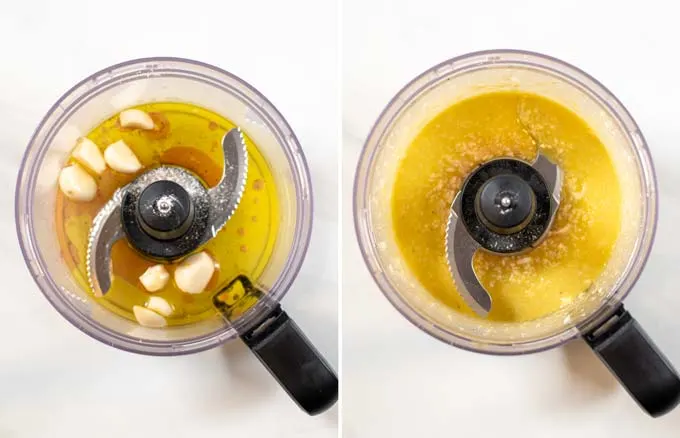
On the other hand, the term “Greek garlic sauce” might be used more broadly to refer to various garlic-infused sauces or dips in Greek cuisine. One popular example is Tzatziki, a sauce made with yogurt, cucumber, garlic, and herbs. Tzatziki has a distinctively tangy flavor from the yogurt and a refreshing quality from the cucumber.
In summary, skordalia is a specific type of Greek garlic sauce with a creamy texture and variations in its base ingredient, while “Greek garlic sauce” could refer to different garlic-infused sauces or dips in Greek cuisine, such as Tzatziki. If you encounter the term “Greek garlic sauce,” it’s helpful to consider the specific context or recipe to understand exactly what is being referred to.
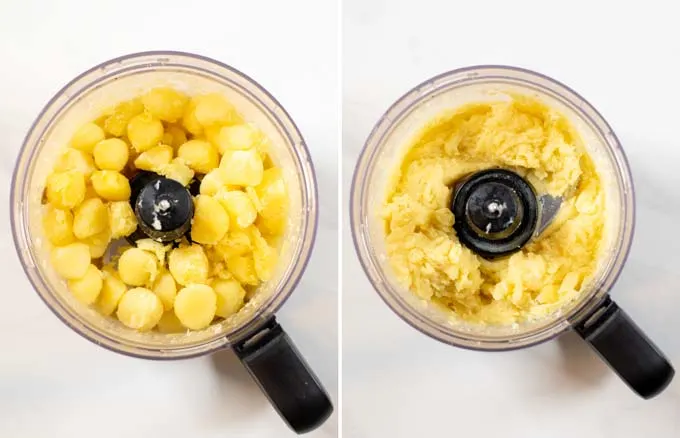
How to make this Skordalia recipe
To make Skordalia, start by cleaning, washing, peeling, and cutting potatoes into small pieces. Cook them until they are very soft.
To make the paste, add 1/3 cup of extra virgin olive oil, leaving the remaining oil for later use, peeled cloves of garlic, and vinegar to a food processor. Pulse everything until it forms a smooth garlic paste.
Next, add the cooked potatoes to the raw garlic paste, followed by the remaining oil, a pinch of salt, and pepper to taste. Alternatively, you can add the remaining oil in a steady stream from the lid into the food processor while it is running. Pulse everything until it becomes super smooth and creamy. This step you could also do with a potato masher.
Finally, serve and enjoy your delicious Skordalia at room temperature.
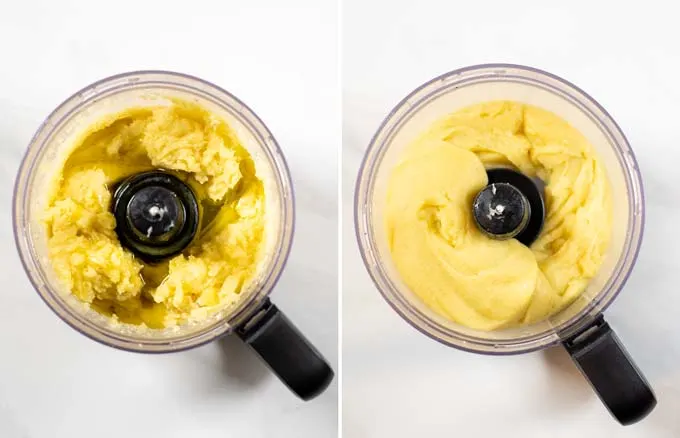
How long is Skordalia good for?
The shelf life of potato skordalia, like many homemade sauces or dips, depends on various factors such as the specific ingredients used, storage conditions, and whether it contains any perishable components like dairy.
As a general guideline, skordalia that is made primarily with garlic, and olive oil can be stored in the refrigerator for about 3-5 days. Keep it in an airtight container to help preserve its freshness.
Always use your judgment and perform a visual and sensory check before consuming leftovers. If you notice any signs of spoilage, such as an off smell, unusual color, or unusual texture, it’s advisable to discard the skordalia.
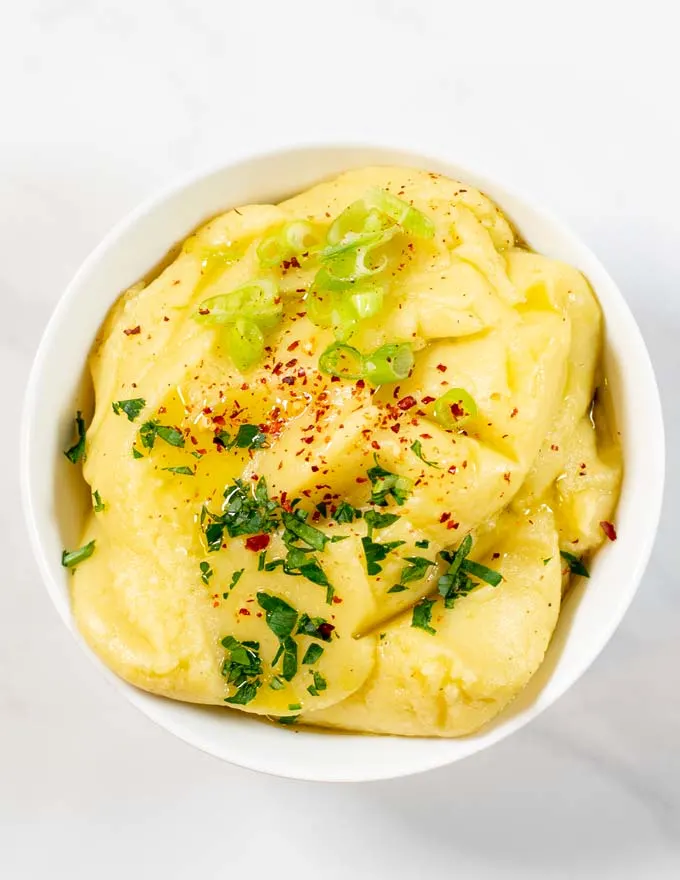
What to serve with Skordalia
Skordalia is a creamy and tangy Greek sauce made with mashed potatoes, garlic, olive oil, and lemon juice. It has a versatile taste profile, making it an excellent addition to a variety of dishes in Mediterranean cuisine. Whether you’re looking for a dip, a dressing, or a sauce, skordalia can add a delicious twist to your meal.
This Green garlic dip is a great accompaniment to grilled meats, seafood, vegetables, pita bread, gyros, souvlaki, fried foods, mashed potatoes, salads, and meze platters. It adds a garlicky and creamy element that can enhance the flavors of the dish. Skordalia can also be used as a dressing for salads, particularly those with a Mediterranean flair. It can add a unique and zesty element to the salad.
Skordalia’s versatility makes it a perfect addition to various dishes in Mediterranean cuisine. You can experiment with different combinations to find what you enjoy the most. Whether you’re a meat lover, seafood enthusiast, or a vegetarian, skordalia can add a burst of flavor to your meal. Give it a try and discover the magic of this Greek sauce.
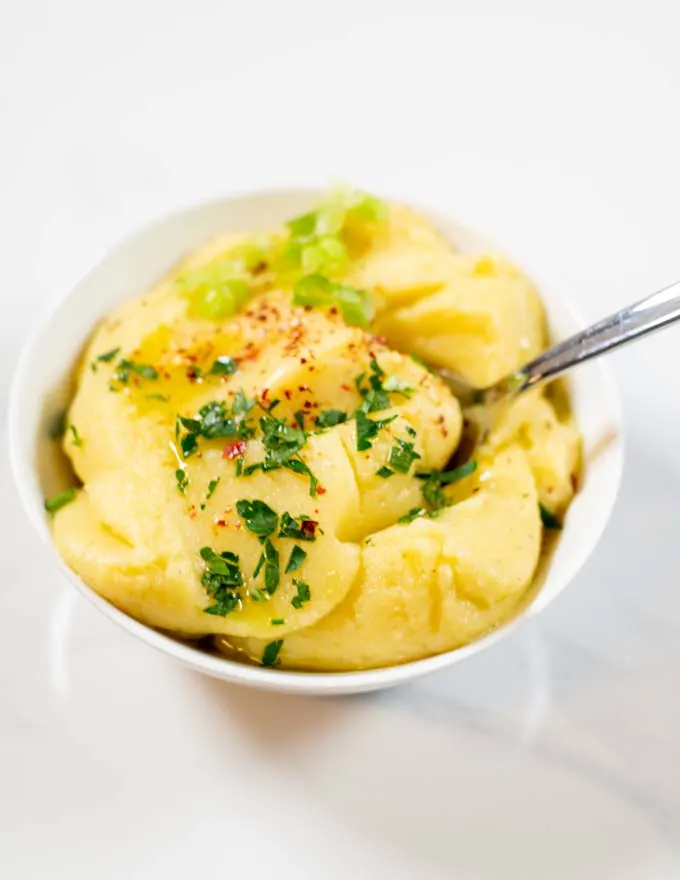
Other Greek recipes to try
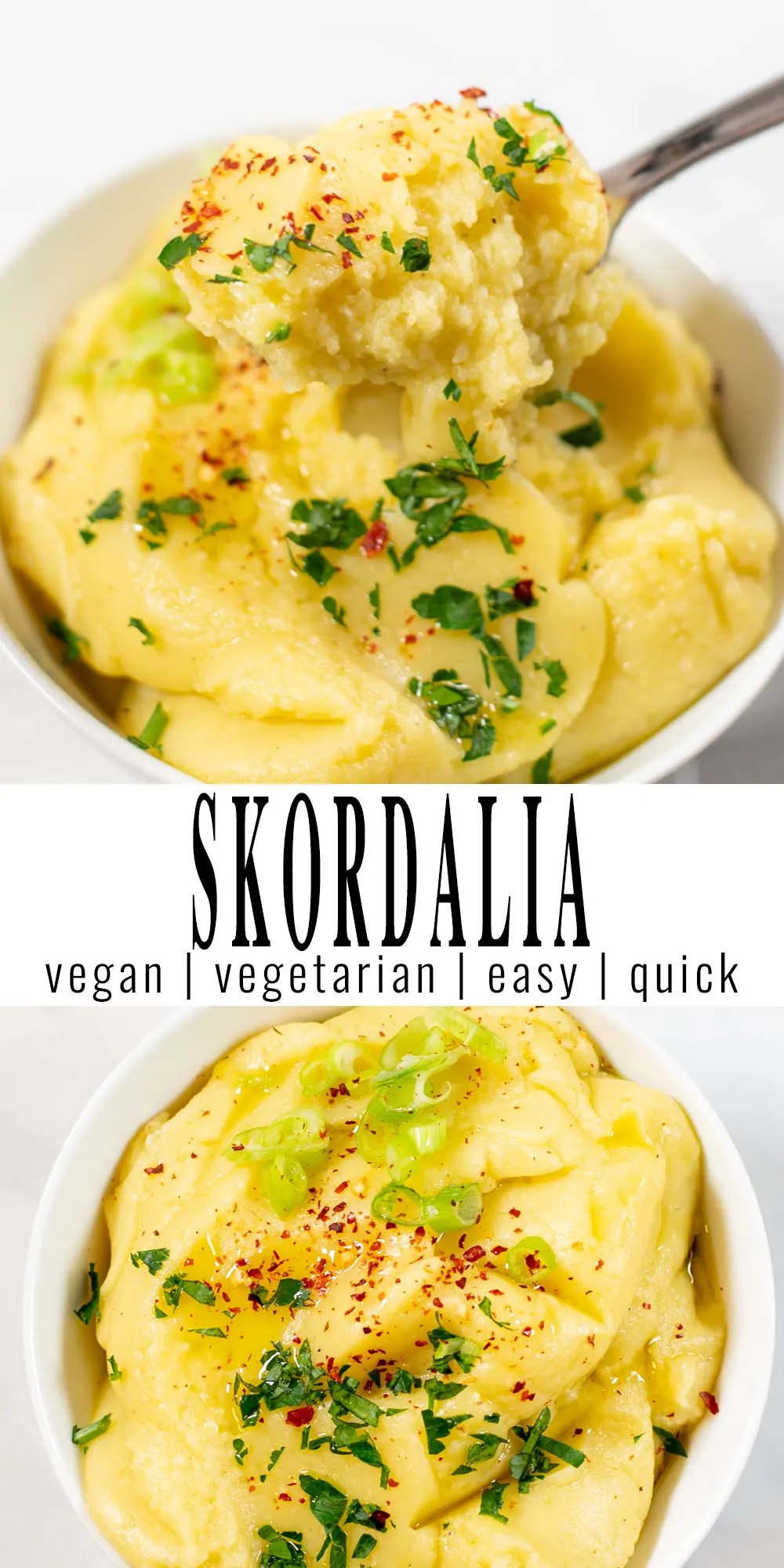
If you enjoy this easy Skordalia recipe, share it with a tag on Instagram or Facebook.
Enjoy, Florian.
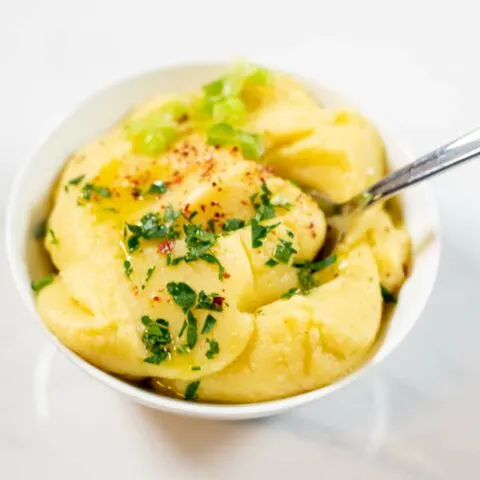
Easy Skordalia Recipe
Skordalia is a creamy, garlicky dip that's perfect for spreading on bread, dipping vegetables, or serving as a side dish. It is a classic Greek dish that has been a staple of Greek cuisine for centuries. If you're a fan of bold flavors and lots of garlic, this recipe is a must-try. Follow this step-by-step guide on how to make the ultimate skordalia at home and treat all garlic lovers with an amazing Greek dip.
Ingredients
- 1 lb potatoes
- 7 cloves garlic
- 1/2 cup olive oil, divided
- 2 tbsp red vinegar
- salt, pepper to taste
Instructions
- Start by cleaning, washing, peeling, and cutting potatoes into small pieces. Cook them until they are very soft.
- To make the paste, add 1/3 cup of extra virgin olive oil, leaving the remaining oil for later use, peeled cloves of garlic, and vinegar to a food processor. Pulse everything until it forms a smooth garlic paste.

- Next, add the cooked potatoes to the raw garlic paste, followed by the remaining oil, a pinch of salt, and pepper to taste. Alternatively, you can add the remaining oil in a steady stream from the lid into the food processor while it is running.

- Pulse everything until it becomes super smooth and creamy.

Notes
Store Skordalia in an airtight container in the fridge for about 3-4 days.
Nutrition Information:
Yield: 6 Serving Size: 1/2 cupAmount Per Serving: Calories: 237Total Fat: 12gSaturated Fat: 3gTrans Fat: 0gUnsaturated Fat: 8gCholesterol: 0mgSodium: 106mgCarbohydrates: 17gFiber: 2gSugar: 1gProtein: 2g